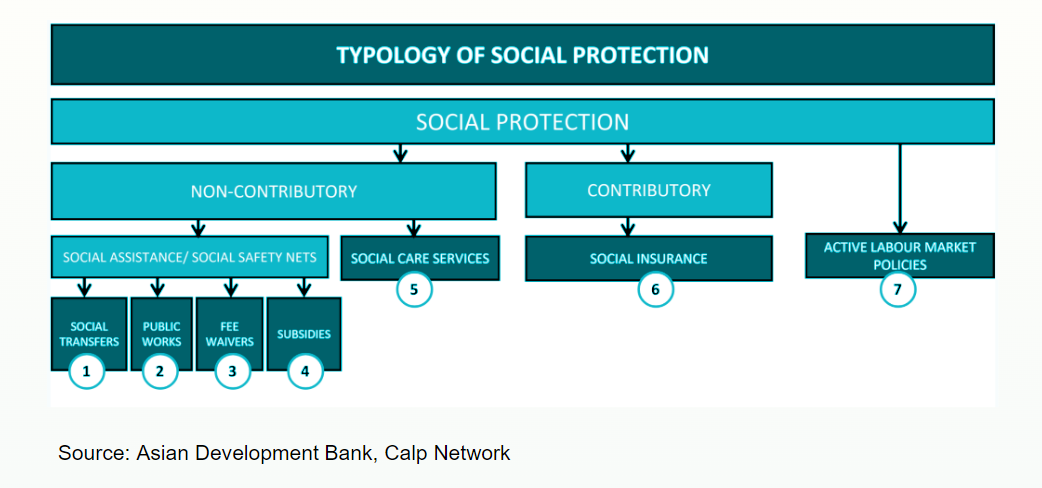Introduction to social protection
Social protection serves as a crucial framework for mitigating poverty and vulnerability, focusing on enhancing labor market efficiency, reducing risk exposure, and strengthening individuals' ability to safeguard against income disruptions.
This article discusses the concept of social protection and looks into the types and categories of social protection programs, including non-contributory and contributory programs. It also discusses the importance of the maturity of social protection systems and their effectiveness during crises.
You can also watch the following webinar to get more information on Cash Voucher Assistance, Social protection and Cash Plus programmes
Understanding social protection
Social protection includes policies and programmes aimed at alleviating poverty and vulnerability by fostering efficient labor markets, reducing exposure to risks, and enhancing the capacity to protect oneself against hazards and interruptions or loss of income.

Social protection refers to a variety of programs and policies designed to support individuals and households. These programs can be categorized based on their funding sources and the methods used to finance the benefits.
Social protection programs fall into two major categories:
- Non-contributory programs are funded through government taxation or external aid without requiring financial contributions from the beneficiaries. Examples include social assistance programs that provide resources to individuals and households, especially those considered poor or vulnerable.
- Contributory programs, on the other hand, include social insurance programs. These are managed or supervised by the government and are funded through contributions made by the participants or on their behalf.
These programmes protect against economic risks caused by shocks and typically serve a defined population. Examples include state pensions for the elderly, national health insurance schemes, and maternity programs.
Non-contributory programs are further divided into social care services and social assistance. Social care services focus on providing social support rather than direct economic assistance or resource transfers. Examples include family support services, child protection services, alternative care for children, and social work support for people with disabilities.
We can further categorize these into distinct types of programs or policies.
For non-contributory programs, there are social transfers, fee waivers, subsidies, and public works:
- Social transfers: These are direct payments or benefits provided by the government or organizations to individuals or households.
- Fee waivers: These involve the removal or reduction of fees for certain essential services, making them accessible to people who might otherwise be unable to afford them.
- Subsidies: Financial assistance provided to reduce the cost of goods and services, making them more affordable for the population.
- Public works: Programs that provide temporary employment opportunities, usually involving infrastructure projects like building roads, schools, or other community facilities.
Contributory programs are subdivided into active labor market policies and social insurance:
- Social insurance aims to provide a safety net for individuals and families during times of need, they ensure access to financial support during life's events that may lead to loss of income or increased expenses.
- Active labor market policies aim to protect existing jobs and stimulate employment. These include measures to prevent workplace exploitation and discrimination, as well as job search services and training programs. These policies primarily benefit those who are employed, particularly within the formal sector.
Maturity of social protection systems
Social protection systems can be either mature or immature, depending on their level of development, effectiveness, and the comprehensiveness of the social safety nets within a particular country or region.
These terms describe the extent to which a social protection system is established, adequately funded, and efficiently functioning to provide support to its defined population. The maturity of social protection systems significantly impacts the ability of humanitarian actors to effectively link and integrate with existing systems. Integration with mature social protection systems enables more efficient and sustainable support for affected populations. Leveraging the strengths and resources of these systems helps address immediate needs and vulnerabilities during crises, enhancing the overall effectiveness of humanitarian response efforts.
We should also consider the maturity of a social protection system around crisis situations. When discussing how different countries protect their people during tough times such as crises or wars, three main situations arise:
- When there is no government assistance due to conflict or war, humanitarian actors should intervene.
- When the protection system efficiently adapts and aids people promptly after a crisis, determining who should act and how they should act becomes crucial.
- When the protection system is shattered due to a crisis, and the government's assistance is limited, international aid organizations step in to provide support.
These scenarios help determine who should offer assistance, the type of aid required, and how it should be delivered. Depending on the circumstances, such as when the system is broken, international aid organizations are typically best suited to provide cash assistance.
However, when the government has some social protection systems in place, even if they are weak, aid groups can assist in strengthening them and provide support through those channels.
Conclusion
This article examines the importance of social protection, providing a comprehensive understanding on various non-contributory and contributory programs for vulnerable populations. It also discussed the maturity of social protection systems and the critical role they play in crisis situations, outlining strategies for effective coordination between humanitarian actors and government systems to enhance resilience and response efforts.
Sources and further readings
Asian Development Bank, & Van Heeswijk, J. P. M. (2003). Our Framework Policies and Strategies Social Protection. In Asian Development Bank.
Ganti, A. (2023,). What is a waiver?. Investopedia.
Lind, J., Sabates-Wheeler, R., Szyp, C., & BASIC Research. (2023). Cash-Plus Programming in Protracted Crises: A review of programmes in contexts of overlapping conflict, forced displacement and Climate-Related Shocks In Basic Research.
Mvukiyehe, E. (2024). What are we learning about the impacts of public works programs on employment and violence?. World Bank Blogs.
Schüring, E. (2021). Social transfers. In Edward Elgar Publishing eBooks. https://doi.org/10.4337/9781839109119.00014
The CALP Network. (2024). The State of the World’s Cash 2023. Chapter 6: Linkages with Social Protection
Team, I. (2024). Subsidies: definition, how they work, pros and cons Investopedia.